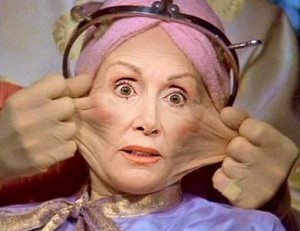 Patients interested in facial rejuvenation are often reticent to proceed for fear of looking worse. Everyone has seen the unfortunate patient with the "Bad Facelift," and patients are unanimous in wanting to avoid it. An additional cause for concern is that if celebrities and even high-profile NFL owners can have Bad Facelifts, how can a more normal patient avoid the same fate? The simple answer is to select a surgeon whose ideals and aesthetics match yours. Ask your surgeon to show you pictures of what they think looks like a very good result. If it looks bad to you, find another doctor. There are several common deformities that are signs of a bad facelift:
Patients interested in facial rejuvenation are often reticent to proceed for fear of looking worse. Everyone has seen the unfortunate patient with the "Bad Facelift," and patients are unanimous in wanting to avoid it. An additional cause for concern is that if celebrities and even high-profile NFL owners can have Bad Facelifts, how can a more normal patient avoid the same fate? The simple answer is to select a surgeon whose ideals and aesthetics match yours. Ask your surgeon to show you pictures of what they think looks like a very good result. If it looks bad to you, find another doctor. There are several common deformities that are signs of a bad facelift:
Stretched /distorted skin When a facelift is done by simply pulling on the skin, that is exactly what it looks like. A patient's face will look like they have wires underneath their skin, much like a puppet! The best way to prevent this, is for the surgeon to perform a "SMAS" procedure, where the surgeon dissects under the facial muscles, and moves the face at this level. The skin can move passively and not looked stretched.
Altered Hairline Frequently when excess skin is repositioned too high, the hairline in the temple area will move up and back, giving the patient a receding hairline. The same is true in a coronal browlift, where the incision in the scalp pulls the hairline back resulting in too large a forehead. Both of these problems are easier to prevent than repair. All that needs to be done is that the incision for each procedure should be at the hairline so that no hair-bearing tissue is removed or repositioned.
Excessively High Brows Nothing scares patients more than the thought of looking surprised for the rest of their lives. Fortunately, excessive brow elevation is easily prevented. The most important thing is for the patient and the plastic surgeon to agree ahead of time what the goal of the procedure is. Again, if you do not agree with your surgeon in this regard, you should find another surgeon.
Rotated or Distorted Ears This is my personal pet peeve. If too much tension is placed on the skin around the ears, two problems can develop. One is that the ear will rotate so it will look more sideways than the normal near vertical. Even worse is when too much tension on the ear lobe causes stretching of the lobe and results in the "Pixie-Ear Deformity." Both of these problems can be prevented if the surgeon makes sure to anchor any tissue under tension to a deep structure such as muscle or bone. When this is done, the ears should look normal after a facelift.
Shotgun Neck This term refers to patients who have had so much tissue, usually fat, removed from their necks that they look like they were shot! This really happens. It is usually the result of overly aggressive defatting of the neck and is most commonly from excessive liposuction in the area.
Misshapen Eyes In attempts to rejuvenate a patients eyes, surgeons may get too aggressive. In one case, excessive pull on the outer aspect of the lower lid can result in an almond shape eye, as one would expect in an Asian patient. Similarly, if too much skin is removed from the lower lid, the lash line will pull down and away from the eye. This results in too much white (sclerae) being seen below the iris and cause patients to have tearing and dry eyes.
Abnormal Motion Probably the worst sign of a bad facelift is when there is abnormal motion in the patient's face. This results from some type of nerve injury so the patients facial muscles can be weak or even paralyzed. This can entail either a subtle weakness in the lower lip to complete inability of the patient to close their eyes.
A facelift procedure causes long lasting changes. To make sure those changes are good ones, make sure the surgeon you select has the same goals as you do and make sure they use techniques that unlikely to result in the deformities I have just discussed.